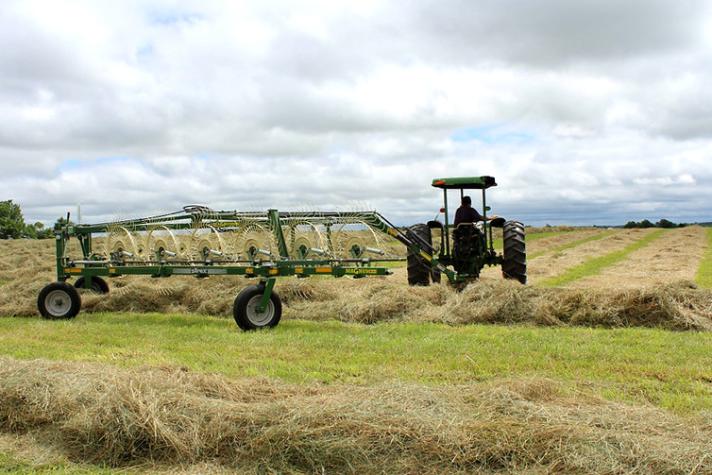NEVADA, Mo. – Rain is always a wild card when deciding the right time to mow hay.
“Pop-up showers and storms are a risk this time of the year,” says University of Missouri Extension agronomist Hunter Lovewell. This unpredictability makes it important to keep an eye on weather forecasts and understand how rainfall affects forage that is drying down but not yet baled, he says.
And not all rains are created equal, says Lovewell. Quick, short rains cause less damage than prolonged, slow rains.
Rained-on hay likely is less digestible with lower yields, respiration and microbial breakdown of the plant tissue.
Lower yields and lower digestibility
Wet hay requires more mechanical handling to dry, which results in leaf shatter. This reduces digestibility when leaves fall and tougher stems remain. Fewer leaves also mean less mass and lower yields, according to research from several universities. When this happens, livestock owners should consider supplementing hay with nutrients, says Lovewell.
Since rain affects grasses and legumes differently, growers should also consider what type of hay they have. Forage legumes such as bird’s-foot trefoil and red clover do not lose as much dry matter as alfalfa does. Most studies agree that crude protein in alfalfa is not greatly affected by rainfall on a mowed crop.
Leaching and respiration
Leaching is the movement and loss of soluble components of the mowed plant. A large portion of the leached out dry matter is soluble carbohydrates, along with lipids, minerals and soluble nitrogen.
Rained-on hay also allows microorganisms such as fungi and molds to develop. Respiration is the process of plant enzymes breaking down soluble carbohydrates. This process occurs whether the forage is rained on or not. It is normal for a small percentage of the total dry matter to be lost through respiration until moisture dries down to around 30%.
Rainfall intensity, length matters
If the total amount of rain is the same, a lower-intensity rain will result in worse quality and lower yield compared to higher-intensity rainfall.
Some research shows that leaching of carbohydrates, vitamins and minerals is usually highest when hay has partially dried and then there is a prolonged rain. Rainfall right after cutting usually results in less leaching of nutrients.
Lovewell says rained-on hay will be better in quality if:
- Rainfall occurs soon after mowing.
- Rainfall is higher in intensity, assuming the rainfall amount is the same.
- Forage is rewetted only once rather than multiple times.
To know the true quality of rained-on hay, or hay in general, submit a forage sample to a lab for testing. “A hay test is the only way to truly know the quality of hay,” says Lovewell.
The analysis from the lab will help in the development of a supplementation program to replace nutrients in the hay.
Lovewell recommends these resources:
- “Rain Damage to Forage During Hay and Silage Making,” University of Wisconsin Extension.
- “Determining the Value of Rained-on Hay,” University of Minnesota Extension.
- “What Is the Effect of Rain Damage on Hay?” University of Delaware.
Photo
Farmer on a tractor raking hay
This time of year, pop-up showers and storms are a risk to hay that has been mowed but not yet baled. Keep an eye on weather forecasts and understand how different types of rainfall affect cut hay, says MU Extension agronomist Hunter Lovewell. Photo by Linda Geist.
